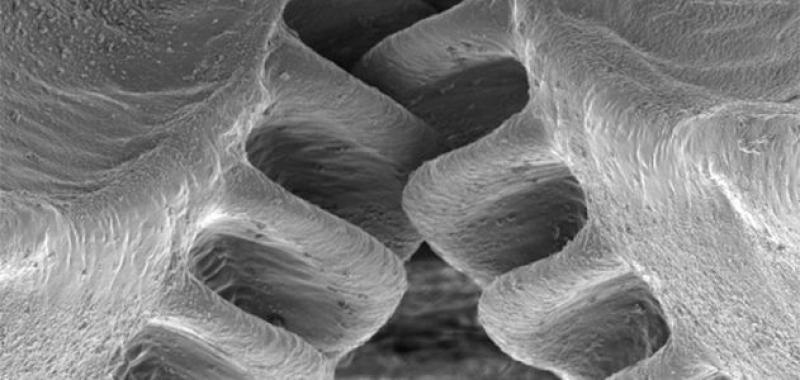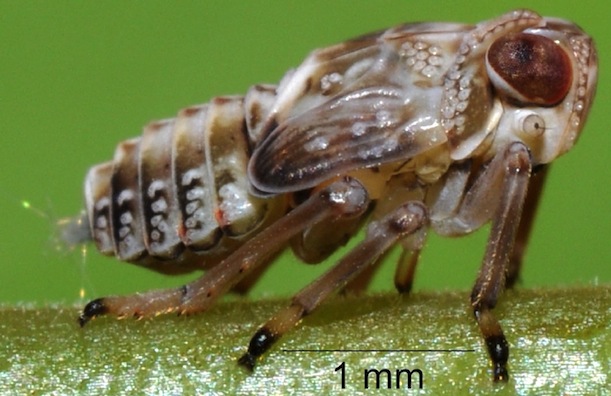This Insect Has The Only Mechanical Gears Ever Found in Nature |Science | Smithsonian Magazine
By: Joseph Stromberg (Smithsonian Magazine)



The small hopping insect Issus coleoptratus uses toothed gears on its joints to precisely synchronize the kicks of its hind legs as it jumps forward
(All images courtesy of Malcom Burrows) By Joseph Stromberg smithsonianmag.com
September 12, 2013
To the best of our knowledge, the mechanical gear—evenly-sized teeth cut into two different rotating surfaces to lock them together as they turn—was invented sometime around 300 B.C.E. by Greek mechanics who lived in Alexandria. In the centuries since, the simple concept has become a keystone of modern technology, enabling all sorts of machinery and vehicles, including cars and bicycles.
As it turns out, though, a three-millimeter long hopping insect known as Issus coleoptratus beat us to this invention. Malcolm Burrows and Gregory Sutton, a pair of biologists from the University of Cambridge in the U.K., discovered that juveniles of the species have an intricate gearing system that locks their back legs together, allowing both appendages to rotate at the exact same instant, causing the tiny creatures jump forward.

Issus coleoptratus

The gears are located on the top segment of each of the insect's hind legs
The finding, which was published today in Science , is believed to be the first functional gearing system ever discovered in nature. Insects from the Issus genus, which are commonly called "planthoppers," are found throughout Europe and North Africa. Burrows and Sutton used electron microscopes and high-speed video capture to discover the existence of the gearing and figure out its exact function.
The reason for the gearing, they say, is coordination: To jump, both of the insect's hind legs must push forward at the exact same time. Because they both swing laterally, if one were extended a fraction of a second earlier than the other, it'd push the insect off course to the right or left, instead of jumping straight forward.
The gearing is an elegant solution. The researchers' high-speed videos showed that the creatures, who jump at speeds as high as 8.7 miles per hour, cocked their back legs in a jumping position, then pushed forward, with each moving within 30 microseconds (that's 30 millionths of a second) of the other.
The finely toothed gears in their legs allow this to happen. "In Issus , the skeleton is used to solve a complex problem that the brain and nervous system can't," Burrows said in a press statement.
The gears are located at the top of the insects' hind legs (on segments known as trochantera) and include 10 to 12 tapered teeth, each about 80 micrometers wide (or 80 millionths of a meter). In all the Issus hoppers studied, the same number of teeth were present on each hind leg, and the gears locked together neatly. The teeth even have filleted curves at the base, a design incorporated into human-made mechanical gears because it reduces wear over time.
To confirm that the gears performed this function, the researchers performed a neat (albeit morbid) trick with some dead Issus . They manually cocked their legs back in a jumping position, then electrically stimulated the main jumping muscle in one leg so that the leg extended. Because it was rotationally locked by the gears, the other non-stimulated leg moved as well, and the dead insect jumped forward.
The main mystery is the fact that adults of the same insect species don't have any gearing—as the juveniles grow up and their skin molts away, they fail to regrow these gear teeth, and the adult legs are synchronized by an alternate mechanism (a series of protrusions extend from both hind legs, and push the other leg into action).
Burrows and Sutton hypothesize that this could be explained by the fragility of the gearing: if one tooth breaks, it limits the effectiveness of the design. This isn't such a big problem for the juveniles, who repeatedly molt and grow new gears before adulthood, but for the mature Issus , replacing the teeth would be impossible—hence the alternate arrangement.
There have been gear-like structures previously found on other animals (like the spiny turtle or the wheel bug), but they're purely ornamental. This seems to be the first natural design that mechanically functions like our geared systems.
"We usually think of gears as something that we see in human designed machinery, but we've found that that is only because we didn't look hard enough," Sutton said. "These gears are not designed; they are evolved—representing high speed and precision machinery evolved for synchronisation in the animal world."
Tags
Evolution

 Article is LOCKED by moderator [Split Personality]
Article is LOCKED by moderator [Split Personality]





I saw this the other day and kept the link on my desk top but Mr. Microsoft rebooted my PC remotely. grrrr
Now I can only find this 2013 article.
Enjoy
I saw an interesting documentary on these little critters a couple years ago, while uniquely evolved and very powerful jumpers their aim seems to be pretty random and could probably use some work.
At the right time of year, walking across the yard creates havoc but you never step on one, lol.
yup
fascinating, lol
I remember the same, but much more modest, on Walt Disney's World, fifty years ago. It was presented as a model for a nuclear chain reaction reaction.
"Nuclear" was still a magic word, with a halo.
1957. the mousetrap thing is about 6 minutes in
and one from Harvard
Watch this guys reaction
I was 10 in 1957.
Disney was a rendezvous we never missed.
Again... fascinating!
Again... thank you.
interesting
but can you fish with them?
... might be a bit small...
So I'll use them for small mouth bass
Split P....if I'm derailing your seed, feel free to delete me. I'm fascinated by insects because of the things they can do, but all I could think of when I saw this bug was "crickets....bet trout would like those"
I think NT and the world can use a bug story now & Then.
Followed by a huge Innuendo article
oh...definitely. did you see Ender's seed about the guy who pimps out corpses in Vegas?
The picture of the perp scared me off, there should be a facial hair license to prevent these tragedies.
Really hard to catch too, lol
It tried it and fell on my face.
Kavika working on his coordination.